Family : Caprimulgidae

Text © Dr. Gianfranco Colombo

English translation by Mario Beltramini
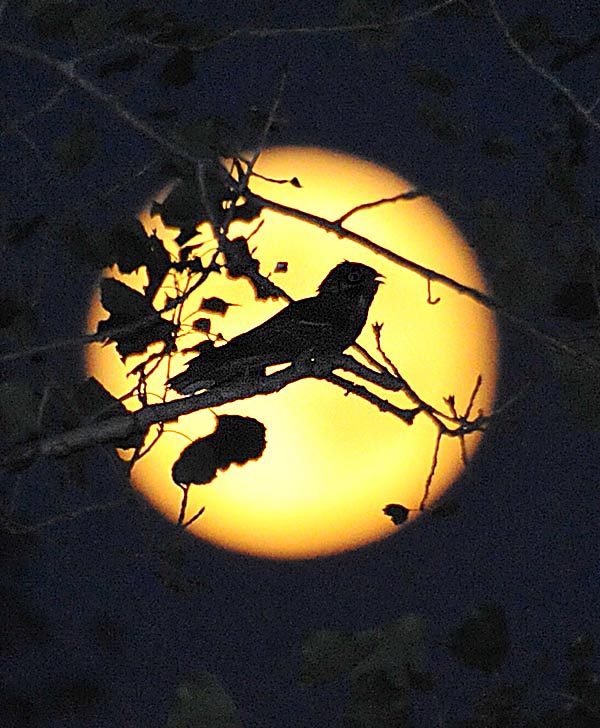
Caprimulgus europaeus singing to the moon. It’s a purely night bird, active in total dark © G. Colombo
The incredible European nightjar or Caprimulgus (Caprimulgus europaeus Linnaeus, 1758) belons to the order of the Caprimulgiformes and to the family of the Caprimulgidae and together with the Red-necked nightjar (Caprimulgus ruficollis) confined to the only Iberian Peninsula, are the two only species of this family present in Europe.
Very few are those who have had the possibility to observe this bird in nature if not real enthusiasts of ornithology and greedy naturalists and among these many have toiled long before finding one hidden, camouflaged on a dry trunk or crouching on the ground like a dry piece of wood.
The European nightjar is a strictly nocturnal bird with an activity starting in the total darkness, flying with skill and dexterity in an elegant and light way, grazing branches and bushes, embankments and buildings, hunting the big insects it nourishes of.
At dawn, just before it gets light, it disappears. It perches among the twigs of a dry trunk fallen on the ground or on a low branch of a twisted tree or, even better, on the ground among pieces of wood, dry leaves and stones where disappears totally from sight.
And that’s not all! Although it already has such a cryptic colouration to render it indistinguishable from everything around, the nature has endowed it also of postures that accentuate this capacity.
It squints its round and black eyes, only sign that might reveal its presence rendering it different from the piece of wood to which is sitting next, to transform them in a tiny longitudinal elongated slot that looks like a small crack in a bark and disappears. Not content of this stance, here, conscious of being invisible, remains at its place almost to the point of being trampled, with an space of escape limited to a couple of metres that allows it the luxury of not revealing itself if not just casually!
Consequently, this is one of the least observed birds and often the population with which it shares the habitat does not even know the existance of this being. Perhaps, it is also for this reason that those who have given it the name are the only ones who in the past times had the opportunity to observe them.
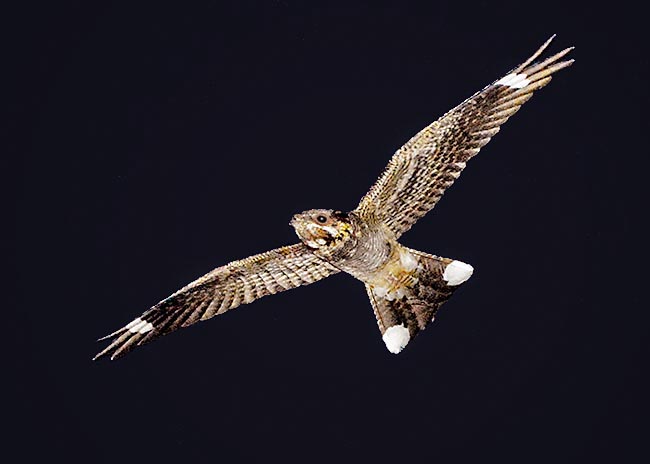
The male differs from the female due to the showy white spots on the tail tip and on the three first remiges © Gianfranco Colombo
In fact, there is no shepherd or guardian of herds who has not had the possibility of coming across this bird during his itinerant life. The progression of the flocks is a true and real careful raking of the crossed area and therefore there is noway for these birds to escape the passage of the animals and during their transit they are inevitably dislodged and flown away.
Furthermore, it is a bird having the size of a cuckoo and with a good wingspan, and so it does not easily escape from view.
There is no doubt that the the name of caprimulgus and then the relevant scientific translation in Latin and also many of the European names based on the same homonymy, has come from the knowledge the shepherds had since always of these birds.
The fact that they were observed in the morning during the first movements of the flocks, had given rise to the doubt that they lived sucking the milk of goats and that these became then sterile and fell in long period of dry and at times they became even blind. From this concept has come then the vulgar name so common and widespread in Europe. Conversely, in the Asian areas where this bird is amply diffused there is no reference to this anecdote and also in France, where, strangely enough, it is called Egoulevent d’Europe, “wind swallower” probably due to its very strange and big mouth.
Although being known as a goat sucker, it is however called also in various names, always quite particular and imaginative.
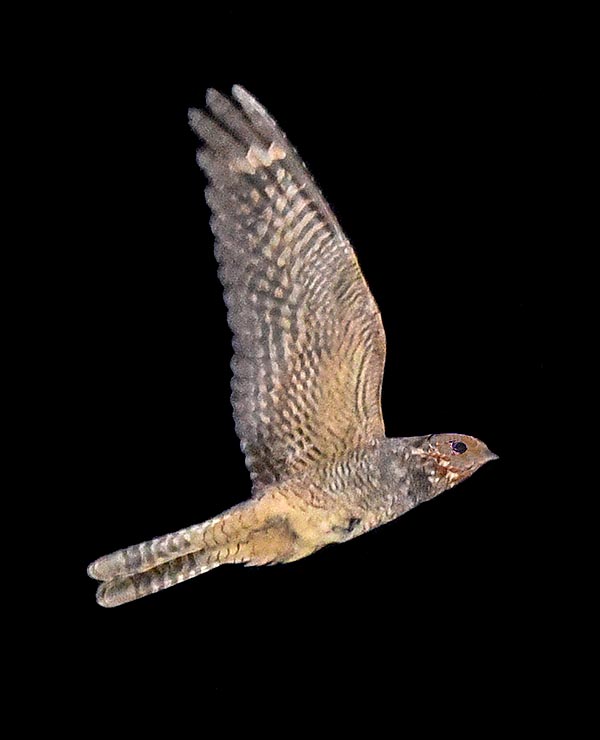
Flying female. The wings are long narrow, like a hawk, and moves them elegantly and fluently © Colombo
Fern owl, Nightjar, Nightraven, Puckeridge (an epithet used also to indicate an old sickness of the goats) and Corpse bird, in English.
Succiacapre, Nottolone, (due to its nocturnal habits), Calcabotto, (because it was thought that when on the ground it perched on the toads=botti) and Bucassa (big mouth), in Italian.
Finally, Gabble ratchet (hound of corpses), referred to an old Anglo-Saxon legend that saw the souls of the unbaptized children wander under the shape of this bird till the Doomsday.
Other European names are: Ziegenmelker, in German; Chotacabras europeo, in Spanish; Noitibó da Europa, in Portuguese; Kaprimulgo, in Esperanto.
Zoogeography
The European nightjar has a vast range wholly covering our continent though leopard spotted and is absent only in the extreme north of the Scandinavian peninsula and in Scotland. It is present in all the Middle East and in Asia in the temperate belt up to Mongolia, nothward, and the Indus valley southwards.
It has few nidifying colonies in Africa along the coasts of Morocco, Algeria and Tunisia, though this continent sees then in the winter season, the arrival of the migration of the whole world population of this bird.
It is a long-distance migrant and during the migration reaches all the sub-Saharan belt of East Africa, from Ethiopia to South Africa. For the migratory line of Western Europe, on the contrary, the wintering areas appear to be placed in correspondence to Senegal and Nigeria. It reaches the nidification areas by late spring and begins the migration towards the winter quarters already from August.
Six subspecies have been determined but the differences with the nominal are fairly minimal except for slightly paler colourations or for minor diversities in the size. Caprimulgus europaeus europaeus, in continental Europe and British Isles up to Siberia, the Caprimulgus europaeus meridionalis, in the Mediterranean area up to Caucasus, the Caprimulgus europaeus sarudnyi in western central Asia, the Caprimulgus europaeus plumipes in Mongolia, the Caprimulgus europaeus dementievi in the Baikal Lake area and Caprimulgus europaeus unwini in easterncentral Asia.
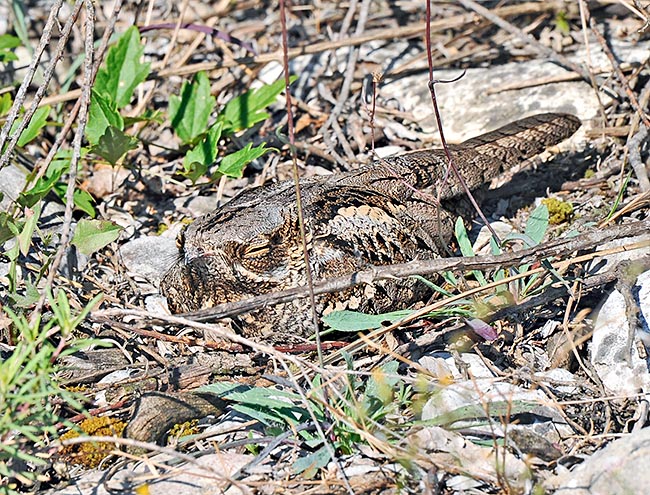
At dawn Caprimulgus europaeus disappears. Perches among the twigs of a fallen dry trunk or on the soil between wood pieces, dry leaves, mosses, small grass and stones. When brooding, female is almost invisible © G. Colombo
Ecology-Habitat
Ideal habitats of the European nightjar are the open and dry spaces rich of insects.
Sandy and pebbly prairies, plantations of trees at first planting, maritime pine forests, military shooting ranges and airports, sandy coastal hinterlands, woods clearings, shrubs and moors areas but always with vast spaces where to fly and hunt the insects it nourishes of.
In Europe rarely reaches altitudes over the 1500 m whilst in Asia and in the wintering sites it is not difficult to encounter it up to more than 3000 m of altitude.
As nidifying on the ground, it needs arid soils with good drainage and without water stagnations which would be detrimental for its nest.
In the moors at times subject to temporary floodings, usually builds the nest on slight elevations of the ground, in order to get a better security.
It is not even afraid of insolation because often the location of the nest is in full sun and during the brooding is able to spend the whole day under a summer and sometimes fiery sun and without any difficulty.
Morpho-physiology
The European nightjar has measures similar to those of a cuckoo or of a small falconet.
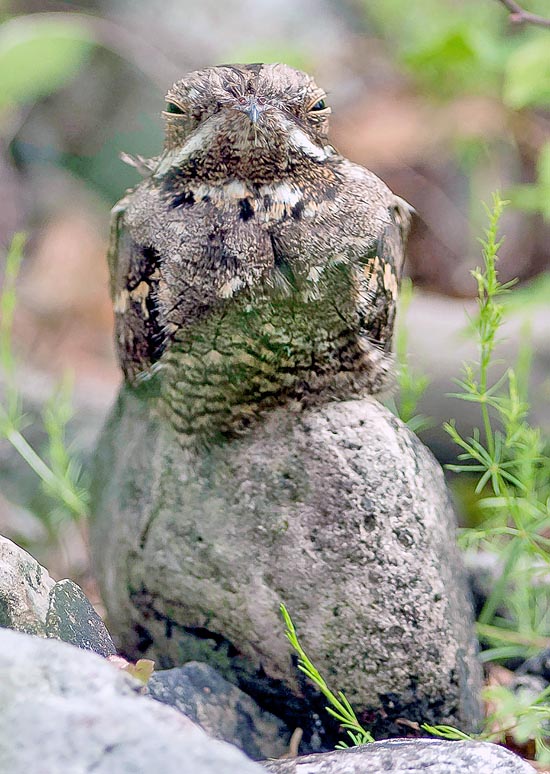
This male, lurking nearby, is no less and seems almost to be merging with the stone © G. Colombo
It is about 30 cm long with a wingspan of even 60 cm and a weight of 100 g and when flying appears much bigger than what might have been thought when stationary.
It has long and narrow hawk wings, it moves with great elegance and good nimbleness and that, combined with the long tail it maneuvers continuously, can twirl and turn with great ease.
The male is slightly bigger but distinguishes only from the female by two big white spots it has on the sides of the terminal belt of the tail and of a short belt, white too, on the first three remiges.
The colour of the adults is a hodgepodge of black, dark brown and white spots, stripes and lines, speckled with each other and so much dappled to imitate perfectly a piece of wrinkled and rotting bark fallen on the soil.
If we consider that when on the ground it shortens its body, crouching the head between the shoulders, squints its big eyes and perfectly lies into a tiny recess, we can well imagine what the outcome will be.
The head is flat and enlarged, with a beak that results very small because hidden by feathers and silky barbells but that conceals a huge mouth, unthinkable for such a bird.
It has very short, practically useless, as on the ground as well as on the branches it stays there with the body and never uses them for walking.
The young, when fledging, are quite similar to the adults even if the colours are not so clear but when newborn and during the first days, they have an incredibly camouflaging livery, maybe even more than the adults.
The feathers of the young have on the borders some whitish filiform smudges that render practically invisible the livery and incomprehensible the shape, making it look like a small piece of wood covered by a slight whitish cobweb.
Furthermore, they keep motionless even when touched, therefore at times it is necessary to finger them for ensuring that they are really small birds.
Instead, after the first week, they become more reactive and during the time lacking to the fledging they show a particular but highly effective aggressiveness. They open wide the enormous mouth, open the wings and the tail and hiss like a snake.
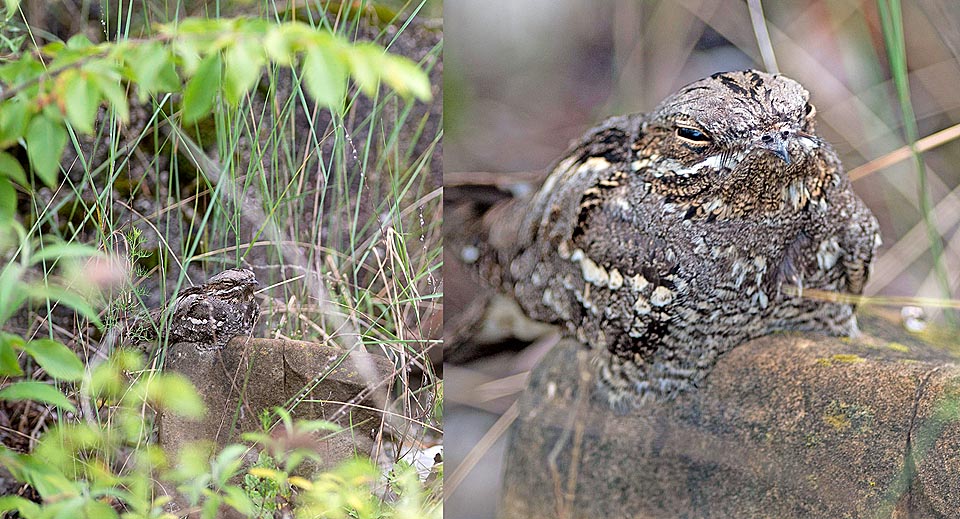
Other well camouflaged male of Caprimulgus europaeus. Though passing a few metres far, often it doesn’t move. Only the flocks, raking the ground step by step, put it to flight. Hence the name of succiacapre (goats sucker in Italian) as the shepherds, seen it flying away among the sheep, thought it sucked their milk © Gianfranco Colombo
Ethology-Reproductive Biology
Its arrival in the nidification quarters is easily revealed by the ceaseless crepuscular and nocturnal singing the male emits while defending its own territory. A continuous cawing quite similar to that of a toad or comparable to the noise of a fan that while turning is hampered by a sprig, with continuous ups and downs of intensity in the sound and spaced every now and then by a tiiiiuuu tek tek tek like a stanza ending. Much more characteristic is the night flight of the male to mark the territory or for flying over the area while the female is brooding.
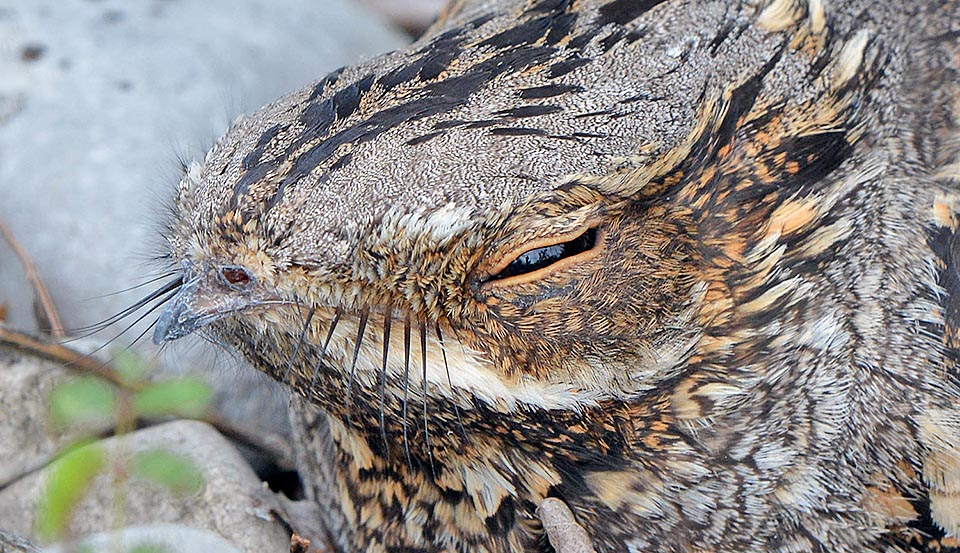
When perched, during the day, the eye becomes a small slit: it almost disappears to sight imitating the cracks of the trees. By night, when flying and opening wide the huge mouth to hunt, a series of hard bristles opens like a fan to form a sort of funnel that leaves little escape to the unfortunate insects © Gianfranco Colombo
A slight flight with very slow beats and long glides with the wings kept vertical like in the harriers (Circus spp), then continuous wheelies and changes of direction and incessantly the emission of an acute and sharp kuik kuik clealy audible from afar. Sometimes it also carries out the Holy Spirit and is able to fly backwards for some metres like the hummingbirds. During these performances often beats its wings upward with a particular pop, a smack that causes a sharp and well audible noise. Also the beak is often used to emit sounds but in this case the noise can be heard only when very close.
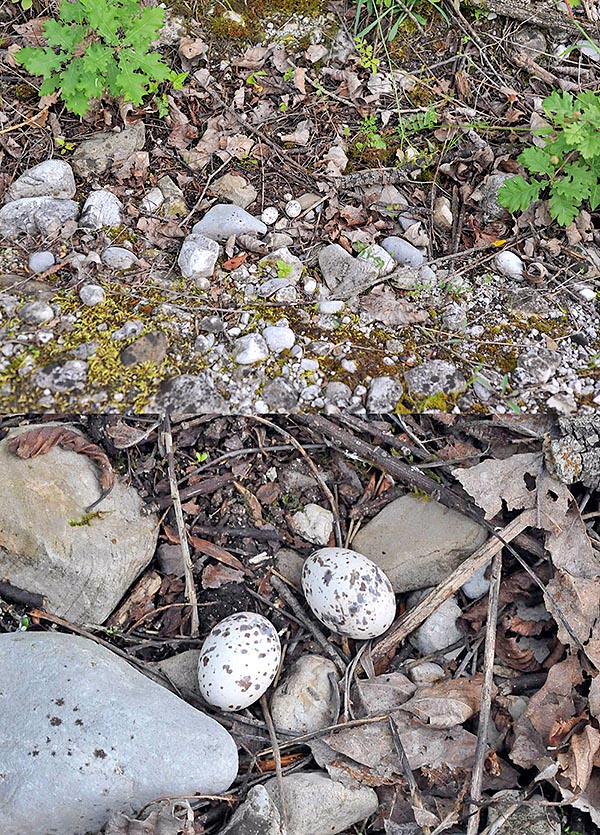
Also the nests are mimetic and the eggs, magnified below, mingle with stones © Gianfranco Colombo
When perching, it does this directly on the ground in a space without vegetation and such to leave it totally uncovered to the sight and relying on its special camouflaging.
At times the male prefers low branches or fallen trunks, fully nestling with the body, along the branch.
The European nightjar nourishes of big moths but also of nocturnal coleopterans caught on the fly during the hunt in the absolute darkness. This bird is equipped with very big black eyes that allow a good vision in the dark especially if helped by the presence of some moon reflection.
It has different hunting period, one initially crepuscular very profitable, spaced by resting periods it spends emitting its usual cawing and then resuming the hunting up to dawn.
During the day it stays absolutely motionless and does not move from its usual shelter. Also the female when on the nest brooding or with the newborns, keeps squatting on the ground all the day long.
The hunt is done keeping the enormous mouth wide open, an unthinkable and unbelievable opening for a bird having these dimensions and moreover furnished on the two sides of a series of hard bristles that open like a fan that conveys the victim towards the mouth, thus increasing even more the capacity of seizure of the prey.
The European nightjar waits for some weeks since its arrival on the nidification site, before mating and spawning. The partners differ for each reproductive period, but keep faithful for the whole season.
Once found the female and chosen the territory, are laid the usual two eggs directly on the ground, not bringing anything to furnish the nest.
A small natural hole of the ground, close to a stone if available or among pieces of wood of a fallen tree and rotting or close to an old dried trunk or, especially in the northernmost ranges, in heather moorlands with small and low bushes but always in open areas. Incredible and unimaginable fidelity in the choice of the reproduction site.
Year after year, the European nightjar gets back in the same places with such a painstaking precision to find it always under the same bush or at the most a few metres farther and not far always on the same stone or on that old trunk now become a relic; the male perched to control the territory. Like the swallows for their nests.
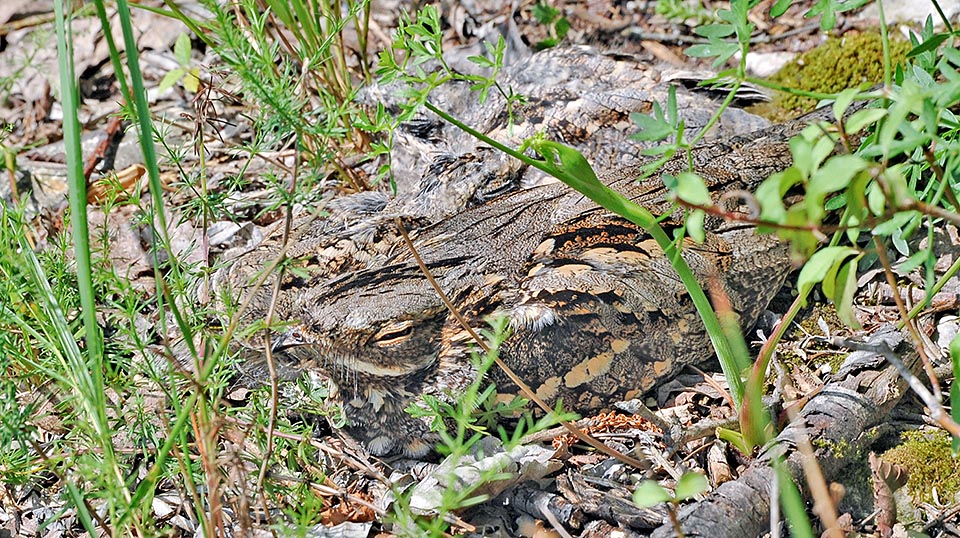
A female and two chicks, almost invisible, that do not move even if touched. The tricks of mimicry are learnt since the birth, close to mummy © Gianfranco Colombo
You find the nest of the European nightjar when you least expect it because it has a great capacity of adaptation and camouflage to the environment it has chosen. Although being a bird of scrublands and often inhospitable places, it does not disdain the presence of the human being and occasionally establishes the nest close to low walls of country houses or near the fences of animals enclosures or even of orchards and country gardens. The eggs are whitish with several ashen grey ochre speckles, partially faded and very faint and the brooding, mainly done by the female, begins simultaneously to the deposition of the first egg and lasts 18 days.
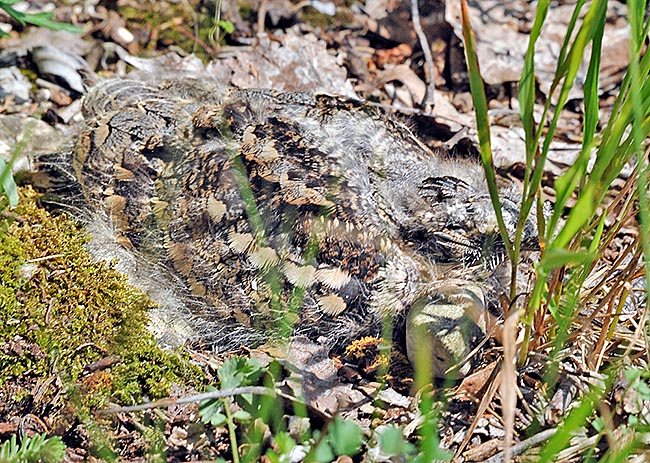
The young feathers have whitish filiform smudges on the edges that seem a webby wood © Gianfranco Colombo
The chicks come to life featherless but in very short time they get feathers and camouflaging down and after some ten days they begin to sneak out of the nest though keeping close to it.
During this time may occur a temporary food shortage due to unexpected bad weather or to adverse climate condi- tions, whereupon the young may fall to hypothermia similar to that charac- terizing the common swifts (Apus apus) that significantly slows the metabolism for some days, allowing these birds to overcome the adversities.
At this stage of growth the female abandons the progeny and begins the second hatch leaving to the male the duty of caring the previous brooding. The independence is reached about one month later. At this time the young leave their home territory and star wandering in the surrounding areas, beginning at times even a real migration towards the wintering lands.
Like all birds nidifying on the ground, the European nightjar has a remarkable number of predators but they also face the same difficulty in discovering the nest, seen the incredible camouflage. The female, when discovered on the nest, often makes the diversion of the fake broken wing trying to take the intruder far away from the brood.
